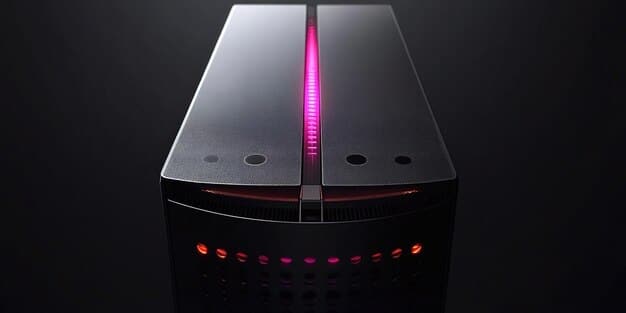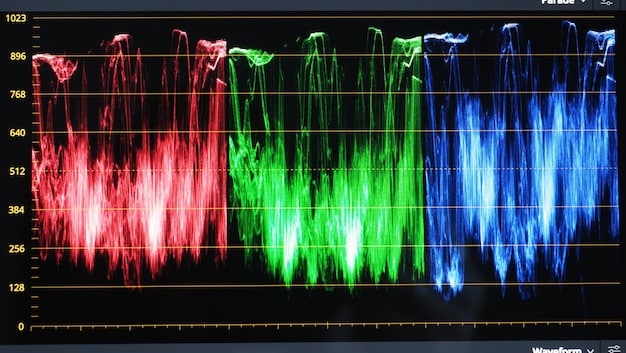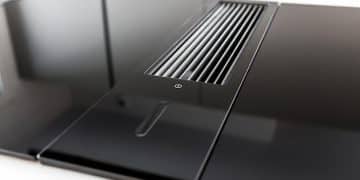Build a Silent Gaming PC for 2025: Ultimate Guide

Achieving a truly silent gaming PC by 2025 involves a meticulous selection of low-noise components, innovative cooling solutions, and strategic noise dampening techniques to ensure an immersive, distraction-free gaming experience.
In the evolving landscape of PC gaming, immersion is paramount, and nothing shatters that immersion faster than a noisy rig. For enthusiasts keen on Building a Silent Gaming PC: Components and Techniques for 2025, the quest for tranquility is not just a preference but a technological frontier that promises unparalleled gaming experiences.
The Core Philosophy of Silence: Understanding Your Enemy (Noise)
Building a silent gaming PC in 2025 isn’t just about throwing quiet parts into a box; it’s a holistic approach to noise mitigation. Every component, every airflow path, and every mounting bracket contributes to the overall acoustic signature of your system. Understanding the sources of noise is the first critical step:
- Fan Noise: The primary culprit, emanating from CPU coolers, GPU coolers, case fans, and even power supply fans.
- Coil Whine: A high-pitched electrical noise often present in GPUs, power supplies, and sometimes motherboards under load.
- HDD Spin-Up: Mechanical hard drives generate audible vibrations and rotational noise, though increasingly less common in gaming PCs.
- Pump Noise: Liquid cooling solutions, while often effective at heat dissipation, can introduce pump whirring or gurgling sounds.
- Airflow Turbulence: Poorly designed cases or fan placements can create turbulent air, leading to a distinct whooshing noise.
The goal is not absolute zero noise, which is practically impossible, but rather to achieve an “inaudible” system under typical gaming loads. This means designing a PC where fan speeds are optimized to keep temperatures low enough to prevent thermal throttling, without creating excessive noise. It’s a delicate balance of thermodynamics and acoustics, ensuring that while your gaming experience is visually stunning and responsive, it remains auditorily serene. This initial understanding sets the stage for component selection and system design, laying the groundwork for a truly quiet build.
Ultimately, the objective is to craft a gaming environment where the only sounds you perceive are those from your game, your headset, or your chosen audio system. This enhances immersion, reduces fatigue during long gaming sessions, and contributes to a more enjoyable overall computing experience. As we delve deeper into specific components and techniques, keep this core philosophy in mind: every choice, no matter how small, contributes to the symphony (or lack thereof) of your silent gaming machine.
Strategic Component Selection: The Foundation of Quietness
The journey to a silent gaming PC begins with a discerning eye for components. Each part plays a crucial role in overall noise output. Choosing wisely here will save you headaches—and decibels—down the line. This section details the key hardware considerations that form the bedrock of your quiet build.
CPU Cooling: Air vs. Liquid
For CPU cooling, both air and liquid solutions have their merits for silent builds. High-end air coolers with large heatsinks and slow-spinning fans can be incredibly quiet and effective. They often excel in passive cooling capability at idle. All-in-One (AIO) liquid coolers or custom loops, when properly managed, can also offer superior thermal performance at lower fan speeds, centralizing heat expulsion through radiators. The key is to select models known for quiet pumps and include radiators large enough to disperse heat efficiently without demanding high fan RPMs. Additionally, ensuring proper mounting of pumps to mitigate vibrations is crucial.
- Choose large, high-quality air coolers with 140mm or larger fans.
- Opt for AIOs with quiet pumps and generous radiator surface area (minimum 240mm, preferably 280mm or 360mm).
- Ensure excellent thermal paste application for optimal heat transfer.
Many modern CPU coolers come with low-noise adaptors or include fans specifically designed for quiet operation. Always check reviews and sound pressure level (SPL) ratings before making a purchase. Remember, a larger cooler often means lower fan speeds for the same cooling performance, translating directly into less noise.

Graphics Cards: The Silent Powerhouse
The GPU is often the loudest component in a gaming PC due to its high power consumption and heat generation. Many manufacturers now offer “silent” or “low-noise” models with oversized coolers, multiple large fans, or semi-passive cooling modes where fans only spin up under heavy load. Look for cards with robust heatsinks and quality fan bearings. Undervolting your GPU can also significantly reduce heat output and fan speeds without a major performance hit, making it a golden technique for silent operation.
- Prioritize GPUs with substantial triple-fan coolers or renowned low-noise designs.
- Consider factory-overclocked cards that might have more efficient cooling out-of-the-box.
- Explore undervolting if your GPU’s noise profile isn’t satisfactory.
It’s worth noting that some high-end GPUs might still produce coil whine, a high-pitched electronic noise, under heavy loads. While not directly related to fan noise, it can be a significant source of auditory distraction. Unfortunately, coil whine is somewhat unpredictable, but choosing reputable brands can minimize the risk.
Power Supply Unit (PSU): Efficiency Equals Quiet
A high-efficiency PSU (e.g., 80 Plus Platinum or Titanium) is not just good for your electricity bill; it’s crucial for silence. More efficient PSUs generate less waste heat, allowing their fans to spin at lower RPMs, or even remain off in semi-passive mode under low loads. Look for PSUs known for their quiet fans and excellent build quality. The fan size and bearing type also play a role; larger fans typically move more air at lower RPMs, contributing to a quieter operation. Some PSUs even feature fluid dynamic bearing (FDB) fans, which are among the quietest.
Choosing a PSU with sufficient wattage for your system, but not excessively overpowered, can also help maintain quiet operation. An unnecessarily powerful PSU might operate at a lower load percentage where its fan profile is less aggressive, but efficiency peaks at certain load levels. A well-matched PSU will operate efficiently and quietly.
Storage: SSDs Reign Supreme
This is perhaps the easiest win for a silent build. Solid State Drives (SSDs), particularly M.2 NVMe drives, produce no mechanical noise whatsoever. They are vastly superior to traditional Hard Disk Drives (HDDs) in terms of speed and silence. While HDDs might still be necessary for mass storage, keeping them separate from your gaming system or opting for external solutions can minimize their impact on noise levels. For the operating system and games, SSDs are non-negotiable for a silent setup.
Case Fans: Quantity and Quality Over Speed
Invest in high-quality case fans with fluid dynamic bearings or similar quiet technologies. Large diameter fans (140mm or 120mm) running at low RPMs are far quieter than smaller fans spinning fast. Aim for a positive air pressure setup (more intake than exhaust) to reduce dust buildup and prevent hot spots. Fan controllers or motherboard fan headers with precise RPM control are essential for fine-tuning your system’s acoustics, allowing you to create custom fan curves that prioritize silence when idle and ramp up only when necessary during intense gaming. Also consider the mounting mechanisms; rubber fan mounts can help dampen vibrations.
When selecting case fans, pay attention to their static pressure rating if they are intended to push air through restrictive areas like radiators, and their airflow (CFM) for open spaces. A balanced approach ensures both effective cooling and minimal noise. RGB lighting is a secondary concern, though many quiet fans now offer subtle or customizable lighting options.
Beyond Components: Advanced Techniques for Acoustic Excellence
Selecting the right hardware is only half the battle. To truly achieve a silent gaming PC in 2025, you need to employ advanced techniques that address noise at its source and prevent resonance. These methods transform a collection of quiet parts into a harmoniously silent system.
Case Selection and Noise Dampening
The PC case acts as an acoustic enclosure. Prioritize cases designed for silence, often featuring sound-dampening materials (like bitumen or dense foam) on panels, solid side panels (instead of tempered glass for absolute silence), and clever airflow designs that minimize turbulence. Look for cases with robust construction to prevent vibrations from resonating through the chassis. Mesh front panels can improve airflow but might marginally increase fan noise; it’s a trade-off to consider based on your thermal needs. Some cases also offer adjustable fan mounts and drive cages that can be outfitted with rubber grommets for vibration isolation.
- Opt for cases with integrated sound-dampening materials.
- Ensure adequate internal space for optimal airflow and component clearance.
- Consider fan mounting options that minimize vibration transfer.
Furthermore, managing cables effectively within the case contributes to good airflow, which in turn helps maintain lower temperatures and thus lower fan speeds. A cluttered case can create hot spots and obstruct air pathways, forcing fans to work harder and louder. Strategic cable routing behind the motherboard tray is not just for aesthetics but for acoustics too.
Optimizing Airflow and Fan Curves
Effective airflow is paramount for silence. A well-designed internal airflow path ensures components remain cool without fans spinning at excessive speeds. Position intake fans to draw cool air efficient, and exhaust fans to expel hot air effectively. Creating a slight positive pressure inside the case (more intake than exhaust) helps prevent dust ingress and ensures a consistent flow of fresh air. Custom fan curves, configured in your motherboard’s UEFI/BIOS or using software, allow you to precisely control fan speeds based on temperature. This is where you fine-tune the balance between performance and acoustics, keeping fans near silent at idle and only ramping them up proportionally when temperatures rise. Experimentation is key to finding the sweet spot for your specific components and usage patterns.
Thermal sensors placed strategically within the case can offer more granular control, allowing specific fan groups to respond to localized heat sources rather than a single CPU or GPU temperature. This advanced level of control ensures that cooling is applied where and when it is most needed, optimizing both performance and noise.
Vibration Isolation and Decoupling
Even the quietest components can transmit vibrations to the case, turning it into a giant resonating chamber. Decoupling components from the chassis is crucial. Use rubber grommets for mounting case fans, hard drives (if you must use them), and even some power supplies. Some cases come with anti-vibration mounts for SSDs and HDDs. Where possible, use anti-vibration washers or screws. For custom water-cooling loops, mount pumps on soft materials or specialized anti-vibration brackets to prevent pump noise from being amplified by the case. This meticulous attention to detail can eliminate subtle but annoying humming sounds.
Keyboard and mouse vibrations can also transmit to your desk, which then transmits to your PC if they are on the same surface. Consider using a large, thick mousepad or a desk mat to absorb these minor vibrations. While this might seem minimal, in a truly silent setup, every little bit helps in achieving an unparalleled quiet environment.
Software Solutions & System Optimization
Hardware selection forms the robust skeleton of your silent PC, but software and operating system optimizations provide the nervous system, enabling your components to work in concert for maximum quietude. These digital tools and techniques allow for granular control and can significantly refine your system’s acoustic profile, especially under varying loads.
Fan Control Software and BIOS Settings
Modern motherboards offer extensive fan control options within their UEFI/BIOS settings or via dedicated software utilities. These allow you to set custom fan curves that dictate fan speed based on CPU, GPU, or even motherboard temperature. For a silent build, the goal is to keep fan RPMs as low as possible while maintaining safe operating temperatures. This often involves setting aggressive fan curves only at higher temperatures, ensuring near-silent operation during idle or light tasks. Experiment with different ramp-up and ramp-down rates to find a balance that prevents sudden, jarring fan speed changes. Some software even allows you to monitor noise levels in real-time or apply “quiet modes” with a single click.
- Utilize motherboard BIOS fan controls for precise RPM management.
- Install vendor-specific GPU tuning software to customize its fan curve.
- Regularly update drivers to ensure optimal thermal management algorithms.
Investing time in understanding and configuring these fan curves is arguably one of the most impactful software-based techniques for silent computing. It allows your system to be dynamically silent, adapting to the demands of your gaming session without requiring constant manual intervention.
Power Management and Undervolting
Optimizing your system’s power management settings can directly impact heat generation and, by extension, fan noise. Windows power plans, for instance, can be configured to “Balanced” or even “Power saver” modes when not gaming, further reducing CPU clock speeds and voltage. For dedicated silent enthusiasts, undervolting the CPU and GPU is a powerful technique. By reducing the voltage supplied to these components while maintaining stable clock speeds, you can significantly lower heat output without a noticeable performance loss. Less heat means fans can spin slower, translating to a quieter system. This is an advanced technique that requires careful testing for stability, but the acoustic rewards can be substantial.
When undervolting, it’s crucial to perform stress tests and benchmarks to ensure system stability. A small reduction in voltage can sometimes lead to instability, so a methodical approach, making small adjustments and incrementally testing, is recommended. The benefits are not only in noise reduction but also potentially in extended component lifespan due to lower operating temperatures.
SSD Maintenance and OS Optimization
While SSDs are inherently silent, optimizing your operating system to heavily utilize them can indirectly contribute to overall quietness by reducing reliance on potentially noisy spinning hard drives. Ensure your OS and frequently played games reside on an NVMe SSD. Regular defragmentation (for traditional HDDs, though not necessary for SSDs) and general system cleanup can prevent unnecessary disk activity, which might otherwise cause fans to spin up due to data transfer processes. Disabling unnecessary background applications and services also lightens the load on your CPU and GPU, helping them stay cooler and quieter.
For those using a hybrid storage solution with an HDD for mass storage, ensure the HDD is configured to spin down after periods of inactivity. This minimizes its operational time and thus its acoustic footprint. Additionally, consider how often you access data on the HDD; if it’s infrequent, an external enclosure might be a better solution for complete isolation.
Monitoring Tools for Continuous Improvement
Utilize monitoring software like HWMonitor, MSI Afterburner (for GPU-specific tweaking), and fan control utilities to keep an eye on temperatures, fan speeds, and component loads. This data is invaluable for fine-tuning your silent build. By identifying which components are generating the most heat or revving up fans unnecessarily, you can make targeted adjustments. Over time, you’ll develop an intuitive understanding of your system’s acoustic behavior, allowing for proactive adjustments to maintain optimal silence. This continuous feedback loop ensures your silent gaming PC remains quiet even as games and loads change.

Moreover, regularly clean your PC from dust buildup. Dust acts as an insulator and can significantly impede airflow, forcing fans to spin faster to compensate. A clean system runs cooler, and a cooler system runs quieter. This simple maintenance step, combined with all the software optimizations, creates a synergy of silence.
The Future of Silent Gaming PCs: What to Expect in 2025 and Beyond
As we look towards 2025 and beyond, the pursuit of truly silent gaming PCs will continue to evolve, driven by advancements in materials science, component design, and cooling technologies. The trends point towards even more integrated solutions and innovative approaches to heat dissipation, potentially redefining what a “silent” gaming rig can achieve. These anticipated innovations promise an even quieter and more immersive gaming future.
Passive Cooling and Vapor Chambers
While full passive cooling for high-end gaming GPUs might remain elusive for mainstream adoption due to sheer heat output, advancements in vapor chamber technology and larger, more efficient heatsinks could lead to more GPUs featuring “zero-fan” or semi-passive modes for even longer durations. CPU coolers are already pushing the boundaries of passive capability, and we might see more robust solutions capable of cooling even mid-range CPUs without active fans during light loads.
The concept of “heat pipes on steroids”—vapor chambers—will become more commonplace, allowing for more efficient heat spread across larger surface areas, contributing to less required airflow. This could mean smaller, quieter fans, or even the potential for fanless operation in less demanding scenarios. Expect to see these integrated into more compact and aesthetically appealing designs.
Advanced Material Science for Noise Dampening
Beyond traditional foam and bitumen, future PC cases might incorporate newly developed acoustic dampening materials that are even more effective at absorbing sound waves without impeding airflow. Think about aerogels or metamaterials that can selectively absorb specific frequencies of noise. These materials could lead to incredibly quiet cases that are also lighter and offer improved thermal performance, solving the inherent trade-off between silence and cooling effectiveness. Such innovations could significantly reduce the need for bulky sound-dampening panels.
Imagine cases with internal structures designed to disrupt sound waves, much like an anechoic chamber, but on a micro-scale within the PC. This kind of advanced material engineering could usher in a new era of completely silent chassis designs that are both functional and visually appealing.
AI-Driven Fan Control and Predictive Cooling
The integration of artificial intelligence and machine learning could revolutionize fan control. Instead of static fan curves, future systems might feature AI-driven fan algorithms that predict thermal loads based on game activity or application usage, pre-emptively adjusting fan speeds to maintain optimal temperatures while minimizing noise. This predictive cooling could eliminate sudden fan ramp-ups, leading to a much smoother and quieter acoustic experience. AI could also learn individual component thermal characteristics and adapt accordingly.
This level of intelligent control would move beyond simple temperature thresholds, incorporating complex variables like CPU and GPU utilization patterns, power draw spikes, and even network activity to anticipate cooling needs. It would make noise management an adaptive process, rather than a purely reactive one.
Miniaturization and Improved Efficiency
Continuing trends in semiconductor manufacturing will lead to more power-efficient CPUs and GPUs, generating less heat. This inherent efficiency will naturally translate into quieter systems as smaller coolers can be used, or existing coolers can operate at lower speeds. As components become more miniature, the thermal design power (TDP) for similar performance levels is expected to decrease, easing the burden on cooling solutions and making true silence more attainable for even compact gaming rigs.
The development of more compact, high-performance components also opens up possibilities for smaller form factor (SFF) silent builds. Currently, cramming powerful components into small cases often compounds heat and noise issues. With increased efficiency and miniaturization, SFF PCs could become genuinely silent gaming powerhouses.
Maintaining Your Silent Rig: Longevity and Performance
Building a silent gaming PC is an accomplishment, but maintaining its acoustic excellence over time requires ongoing attention. Just like any high-performance machine, a silent PC benefits from regular care and optimization. This section outlines the essential practices to ensure your tranquil gaming sanctuary remains that way for years to come, protecting your investment in low-noise components and meticulous building techniques.
Regular Dusting and Cleaning
Dust is the nemesis of silence. It accumulates on heatsinks, fans, and inside the case, forming insulating layers that trap heat and force fans to spin faster to compensate. Regularly cleaning your PC with compressed air is crucial. Pay particular attention to CPU heatsinks, GPU fins, and power supply fan intakes. Ensure your filters are clean and properly seated. A clean system runs cooler, and a cooler system runs quieter. This simple, routine maintenance is perhaps the most impactful action you can take to preserve your PC’s low-noise profile.
Consider the environment where your PC is placed. A dusty room, or one with pets, will necessitate more frequent cleaning. Investing in high-quality dust filters for your case intakes can significantly reduce the amount of dust that enters the system, extending the time between deep cleans.
Monitoring Component Health
Beyond temperature and fan speed, keeping an eye on the overall health of your components can prevent noise issues before they start. Tools that monitor hard drive health (SMART data), power supply voltages, and memory usage can provide early warnings of potential failures. A dying fan bearing or a struggling power supply can quickly become a significant noise source. Addressing these issues proactively, or replacing failing components, is key to maintaining silence. Many motherboard BIOS and monitoring software offer basic health checks.
Pay attention to any new or unusual noises. A sudden whirring, clicking, or grinding sound is a clear indicator that something within your system needs attention. Don’t ignore these auditory cues; they can be the first sign of a component nearing its end of life.
Updating Drivers and Firmware
Stay current with your motherboard BIOS, GPU drivers, and other peripheral firmware. Manufacturers frequently release updates that include performance optimizations, bug fixes, and sometimes, improved fan control algorithms or power management profiles. These updates can directly contribute to lower temperatures and more efficient fan operation, helping to maintain your silent PC’s acoustic performance. Always download drivers directly from the component manufacturer’s official website to ensure compatibility and stability.
Specific attention should be paid to GPU drivers, as they often contain significant updates related to fan curves and power states. A properly optimized driver can allow your GPU to run cooler and quieter under various gaming loads, which is crucial for a silent gaming experience.
Optimizing Game Settings
While a silent PC is built to handle gaming loads, sometimes even the quietest system can be pushed to its limits by demanding titles. Optimizing in-game graphics settings can significantly reduce the load on your GPU and CPU, leading to lower temperatures and subsequently lower fan speeds. Consider adjusting settings like anti-aliasing, shadow quality, or render scale if you find your PC becoming audible during intense gaming sessions. Finding the balance between visual fidelity and acoustic comfort is part of the ongoing optimization process for a silent gaming rig.
Strategic Placement of Your PC
The physical location of your silent gaming PC can surprisingly impact perceived noise levels. Placing it on a hard, resonant surface (like a bare wooden desk) can amplify any residual vibrations. Consider placing the PC on a sound-absorbing mat, particularly if it’s on the floor or directly on your desk. Positioning it away from walls can also help prevent sound waves from reflecting and intensifying. Every element, from the internal components to the room’s acoustics, plays a role in the ultimate quietness of your gaming experience.
| Key Point | Brief Description |
|---|---|
| 🎧 Component Selection | Choose CPUs, GPUs, PSUs, and cases designed for low noise output. |
| 🌬️ Airflow Optimization | Strategic fan placement and custom fan curves reduce noise while ensuring effective cooling. |
| 🔇 Vibration Isolation | Use rubber grommets and sound-dampening materials to prevent case resonance. |
| 🛠️ Software Fine-Tuning | Utilize BIOS/software for fan control and consider CPU/GPU undervolting. |
Frequently Asked Questions About Silent Gaming PCs
▼
Achieving “absolute” silence is challenging due to moving parts and electrical currents, but a gaming PC can be built to be inaudible under typical gaming loads, often referred to as “acoustically invisible.” This requires careful component selection, strategic cooling, and effective noise dampening techniques. It’s a continuous optimization process for quiet operation.
▼
No single component is most crucial; it’s a holistic approach. However, cooling solutions (CPU cooler, GPU cooler, and case fans) are often the primary sources of noise. Therefore, prioritizing high-quality, quiet fans and large heatsinks for these components has the greatest impact on overall system acoustics. Solid-state drives (SSDs) are also essential for eliminating mechanical drive noise.
▼
Yes, liquid cooling, particularly All-in-One (AIO) solutions, can be excellent for silent builds. They can dissipate heat more efficiently, allowing radiator fans to spin at lower RPMs. The key is to select units with quiet pumps and sufficient radiator size to avoid high fan speeds under load. Custom loops offer even more control but require more expertise.
▼
Absolutely. Undervolting your CPU and GPU reduces the voltage supplied to them without significantly impacting performance. This directly leads to lower power consumption and, more importantly, less heat generation. Less heat means fans don’t need to spin as fast, resulting in a significantly quieter system. It’s a highly effective technique for acoustic optimization.
▼
Case selection is fundamental. Silent PC cases feature sound-dampening materials, robust construction to prevent vibrations, and optimized airflow paths to reduce turbulence. A good case minimizes noise escaping and prevents internal components from resonating. It acts as an acoustic shield, ensuring that even perfectly quiet components remain so once installed within the system.
Conclusion
Building a Silent Gaming PC: Components and Techniques for 2025 is far more than an assembly process; it’s an art form that combines meticulous component selection, nuanced cooling strategies, and precise software optimization to create an immersive gaming experience free from auditory distractions. From choosing the quietest fans and most efficient PSUs to applying advanced undervolting and vibration isolation techniques, every decision contributes to the symphony of silence. As technology progresses, the future promises even more innovative solutions, from AI-driven fan control to advanced material science, making the dream of an acoustically invisible gaming rig an increasingly attainable reality for a growing number of enthusiasts. The ongoing commitment to maintenance, recognizing that dust and aging components can erode hard-won tranquility, is the final step in ensuring your silent sanctuary remains so for years to come.





